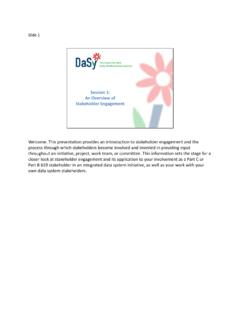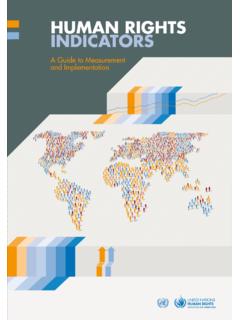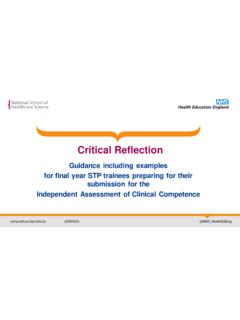Transcription of A bite size guide to running focus groups for patient and ...
1 09 running focus groups for patient and Public engagement A bite-size guide to:Publications gateway reference: 0542201 guide 09: A bite-size guide to Run focus groups for patient and public engagement Getting startedCore principlesPractical StepsWant to learn more?Other bite-size guides01 02 03 04 05 06 07 08 09 NHS England is committed to ensuring that public and patient voices are at the centre of shaping our healthcare services. Their views should inform service development. This will mean large consultation pieces as well as smaller, more focused sessions developed to listen to individuals, particularly those who don t usually engage in public consultations. Getting started02 guide 09: A bite-size guide to Run focus groups for patient and public engagement Getting startedCore principlesPractical StepsWant to learn more?
2 Other bite-size guides01 02 03 04 05 06 07 08 09 Core principlesFocus groups are a method to generate a great deal of information from a range of diverse opinions efficiently and at a relatively low is useful way of working with groups who have limited literacy ( younger children or those with learning disabilities), or those whose first language is not English and more vulnerable inclusion health data which results from a focus group requires some skill to analyse the narrative 09: A bite-size guide to Run focus groups for patient and public engagement 01 02 03 04 05 06 07 08 09 Core principlesFocus groups are about insight through guided group discussion, where participants share their thoughts, feelings, attitudes and ideas on subjects. They bring a rich source of data in participants own words and develop deeper insights.
3 focus groups are often quick, easy to organise and extremely useful to engage with small groups of people. Hearing individual perspectives and voices, they are a useful way of engaging with marginalised groups who are often missed out of participation is important to ensure people attending feel secure and confident. It can also be useful to invite people to take part through trusted intermediaries, which includes working with stakeholder organisations who are already working with the groups that you are trying to reach, it can be useful to invite people to take part through trusted startedCore principlesPractical StepsWant to learn more?Other bite-size guides04 guide 09: A bite-size guide to Run focus groups for patient and public engagement 01 02 03 04 05 06 07 08 09 Getting startedCore principlesPractical StepsWant to learn more?
4 Other bite-size guidesPractical Steps1. Work in partnership with community based organisations to develop and invite attendees. It is useful to use community based venues, in the heart of the communities who are being invited, ensuring good access and a familiar and comfortable environment2. When running a focus group aim for between 6-12 people and about an hour and a half seminar Ensure there is a good facilitator for the focus group with a lived experience or service user/carer insight. This is vital to ensure that all voices are heard (not just the loudest) and that any different perspectives, where participants disagree with each other, are explored. 4. Develop some topics for discussion in advance this will structure a guided 05 guide 09: A bite-size guide to Run focus groups for patient and public engagement 01 02 03 04 05 06 07 08 09discussion.
5 The topics should be designed with the overall engagement themes or research questions in Be clear how the session will be recorded/noted and fed into the wider work programme so that participants are clear about the purpose and outcomes of the focus It is essential that participants understand that their participation is voluntary and that there are no consequences in not taking part or answering specific questions. 7. Terms of confidentiality need to be agreed. It can be useful to take the approach of a confidential discussion ( what is shared in the room, stays in the room and anonymity guaranteed), but in some cases people may want their experiences to be Agree ground rules for the group respect for other people s views and allowing space to talk. 9. It is useful to have 2 people conducting the focus group ; one as a facilitator and the other as a scribe.
6 10. Ensure that the findings from the focus group are shared with the participants and that their time and hard work is valued and StepsGetting startedCore principlesPractical StepsWant to learn more?Other bite-size guides06 guide 09: A bite-size guide to Run focus groups for patient and public engagement 01 02 03 04 05 06 07 08 09 The NHS Institute for Innovation and Improvement used focus groups to work with patients and families, as well as children and young people, to develop the 15 Steps Challenge a toolkit used by providers and commissioner quality assurance teams to gain insight into the quality of care that patients receive. The toolkit took its name from a parent saying in a focus group I can tell what kind of care my daughter is going to get within 15 steps of walking on to a ward.
7 focus groups often yield very powerful, personal stories that can support and drive StepsGetting startedCore principlesPractical StepsWant to learn more?Other bite-size guides07 guide 09: A bite-size guide to Run focus groups for patient and public engagement 01 02 03 04 05 06 07 08 09 Getting startedCore principlesPractical StepsWant to learn more?Other bite-size guidesWant to Learn More?Social Research unit Update 19: focus groups Basics for conducting focus groups How to run focus groups 09: A bite-size guide to Run focus groups for patient and public engagement 01 02 03 04 05 06 07 08 09 Getting startedCore principlesPractical StepsWant to learn more?Other bite-size guidesOther Bite-Size GuidesClick on the links below to download each of our bite-size guides to participation.
8 Additional guides are in guide 1 Principles for Participation in CommissioningBite-size guide 2 Governance for ParticipationBite-size guide 3 Planning for ParticipationBite-size guide 4 Budgeting for ParticipationGuides 5 -15 are also available via the following link: 09: A bite-size guide to Run focus groups for patient and public engagement 01 02 03 04 05 06 07 08 09 Getting startedCore principlesPractical StepsWant to learn more?Other bite-size guidesDate: June 2016 Publications gateway reference: 05422 NHS England s series of Bite-size guides aims to help colleagues plan and deliver the best possible patient and public participation, in line with Transforming Participation in Health and further information, please contact by the Public Participation team at NHS is an interactive PDF: To navigate, use the arrow buttons at the bottom or the main menu on the left side of the @NHSE ngland 0113














